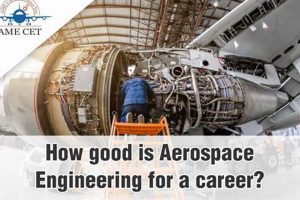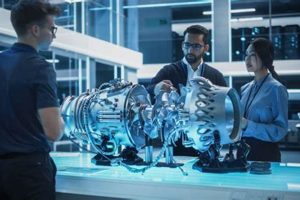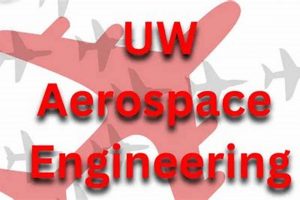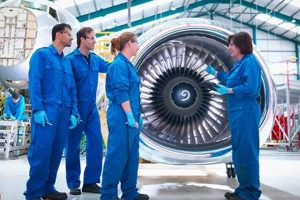Aerospace engineers conceive, design, develop, and test aircraft, spacecraft, satellites, and missiles. This encompasses the creation of vehicles that operate within Earth’s atmosphere and beyond, including their propulsion systems, control systems, and structural integrity. For example, they might be involved in the design of a commercial airliner, a space shuttle, or a communication satellite.
The endeavors of these professionals contribute significantly to global transportation, scientific discovery, and national security. Advancements in aviation have reduced travel times and connected people across continents. Spacecraft enable exploration of the solar system, providing valuable data about our universe. Satellites facilitate communication, navigation, and weather forecasting, benefiting a multitude of sectors. The historical context of their work is rooted in the relentless pursuit of flight and space exploration, consistently pushing the boundaries of technological capabilities.
The following sections will delve into the specific types of projects undertaken in this field, the design processes employed, and the impact of these creations on society. Furthermore, it will explore the interdisciplinary nature of the field and the key challenges aerospace engineers face in their ongoing work.
Insights into Aerospace Engineering Creations
This section provides key considerations relevant to understanding the scope of aerospace engineering outputs and their societal impact. Focus is placed on the tangible aspects of their creations, rather than abstract concepts.
Tip 1: Prioritize Functionality: Designs must prioritize operational performance and safety within extreme environments. Examples include ensuring engine reliability at high altitudes or radiation shielding for spacecraft components.
Tip 2: Emphasize Aerodynamic Efficiency: Achieving minimal drag and optimal lift is crucial for fuel economy in aircraft and maneuverability in missiles. Wind tunnel testing and computational fluid dynamics play vital roles here.
Tip 3: Incorporate Lightweight Materials: Utilizing materials like composites and advanced alloys reduces weight, improving performance and fuel efficiency. Consider titanium alloys for high-stress components and carbon fiber for fuselage panels.
Tip 4: Integrate Advanced Control Systems: Implementing sophisticated control systems allows for precise maneuvering and stability in flight, particularly in unstable configurations. Fly-by-wire systems are commonplace in modern aircraft.
Tip 5: Focus on Structural Integrity: Ensuring that airframes and spacecraft structures can withstand extreme loads and stresses is paramount. Finite element analysis is used to predict stress distribution under various conditions.
Tip 6: Optimize Propulsion Systems: Selecting the appropriate propulsion system, be it jet engines, rocket engines, or electric propulsion, is critical for meeting mission requirements. Considerations include thrust-to-weight ratio and specific impulse.
Tip 7: Consider Environmental Impact: Designing aircraft and spacecraft with reduced emissions and noise pollution is increasingly important. Research into alternative fuels and quieter engine designs is essential.
These insights highlight the multifaceted nature of creating functional and impactful aerospace systems. A focus on performance, safety, and sustainability drives innovation in this dynamic field.
The subsequent sections will explore the educational pathways to a career in aerospace engineering, the key skills required, and the future trends shaping the industry.
1. Aircraft
Aircraft are a primary manifestation of aerospace engineering principles. The development of fixed-wing and rotary-wing aircraft necessitates expertise in aerodynamics, propulsion, structural mechanics, and control systems. Every aspect, from the initial conceptual design to the final assembly and testing, relies on the knowledge and skills of aerospace engineers. The relationship is causal: the design requirements and operational objectives drive the engineering processes employed. For example, the need for increased fuel efficiency in commercial airliners has led to advancements in wing design and engine technology, all spearheaded by aerospace engineers.
The importance of aircraft within the scope of aerospace engineering is undeniable. They serve as a critical component, illustrating the integration of numerous sub-disciplines within the field. Consider the Boeing 787 Dreamliner: its composite airframe, advanced avionics, and efficient engines exemplify the application of cutting-edge aerospace engineering techniques. Furthermore, military aircraft, such as the F-35 Lightning II, demonstrate the application of stealth technology, advanced sensor integration, and high-performance propulsion systems, underscoring the role of aerospace engineers in national defense.
A comprehensive understanding of aircraft design and operation is practically significant for advancements in air transportation, defense capabilities, and space exploration. Continued research and development in areas such as hypersonic flight and electric propulsion are vital to address future challenges and maintain technological leadership. These endeavors also necessitate addressing complex issues related to safety, environmental impact, and regulatory compliance, highlighting the interdisciplinary nature of aerospace engineering.
2. Spacecraft
Spacecraft represent a core category of outputs directly resulting from the work of aerospace engineers. Their design, development, and operation demand expertise across a broad spectrum of engineering disciplines, making them a prime example of the complex creations originating from this field.
- Orbital Mechanics and Trajectory Design
Aerospace engineers are responsible for calculating and designing the trajectories that spacecraft follow. This includes determining the optimal launch windows, orbital parameters, and maneuvers required to achieve specific mission objectives. Examples range from placing communication satellites in geostationary orbit to planning interplanetary missions to Mars. Precise calculations are crucial for mission success, minimizing fuel consumption, and ensuring accurate data collection.
- Spacecraft Structures and Thermal Control
The structural integrity of a spacecraft is paramount, as it must withstand the stresses of launch and the harsh environment of space. Aerospace engineers design lightweight yet robust structures capable of withstanding extreme temperatures, radiation, and micrometeoroid impacts. Thermal control systems are essential for maintaining optimal operating temperatures for onboard equipment, preventing overheating or freezing. These systems may include insulation, radiators, and active cooling mechanisms.
- Propulsion Systems for Spacecraft
Spacecraft rely on various propulsion systems to maintain their orbits, perform maneuvers, and travel through space. Aerospace engineers design and develop these systems, which can include chemical rockets, electric propulsion systems, and even solar sails. The choice of propulsion system depends on the mission requirements, with factors such as thrust, specific impulse, and fuel efficiency playing critical roles. For instance, ion drives are used for long-duration missions, while chemical rockets provide high thrust for initial launch and orbital insertion.
- Communication and Control Systems
Establishing and maintaining communication with spacecraft is vital for transmitting data and controlling onboard systems. Aerospace engineers design and implement communication systems that can reliably transmit data over vast distances. Control systems are necessary for maintaining spacecraft orientation, pointing instruments, and executing maneuvers. These systems often incorporate sophisticated sensors, actuators, and algorithms to ensure precise control and autonomous operation.
The design and deployment of spacecraft showcases the breadth and depth of aerospace engineering capabilities. These complex systems, encompassing structural integrity, propulsive power, effective control, and consistent communications highlight the practical application of theoretical concepts. Examples such as the James Webb Space Telescope underscore the pivotal role of aerospace engineers in furthering scientific discovery and pushing the boundaries of human knowledge.
3. Satellites
Satellites stand as a prominent outcome of aerospace engineering endeavors. Their creation necessitates the application of diverse engineering principles, including orbital mechanics, communications engineering, and power systems design. The direct relationship between aerospace engineering and satellites is causative: the need for enhanced communication, navigation, and remote sensing capabilities drives the design and deployment of these space-based assets. Satellites serve as a critical component of aerospace engineering output, illustrating the practical application of theoretical knowledge.
The importance of satellites is underscored by their multifaceted applications. Communication satellites facilitate global connectivity, enabling telecommunications, broadcasting, and internet access. Navigation satellites, such as those in the Global Positioning System (GPS), provide precise location data for civilian and military applications. Earth observation satellites gather data for weather forecasting, environmental monitoring, and resource management. For example, the Landsat program, a joint initiative between NASA and the U.S. Geological Survey, has provided continuous satellite imagery of Earth’s surface since 1972, supporting scientific research and land management decisions. The practical significance of understanding satellite design and operation is reflected in their widespread use across various sectors.
In summary, satellites represent a tangible manifestation of aerospace engineering expertise. Their impact on global communication, navigation, and scientific research highlights the crucial role of aerospace engineers in developing and deploying these vital space-based systems. The ongoing development of more advanced satellite technologies presents challenges related to cost, reliability, and orbital debris mitigation. However, continued innovation in this field is essential for addressing future societal needs and advancing scientific knowledge.
4. Missiles
Missiles represent a specific category within the broader spectrum of aerospace engineering outputs. Their creation demands a focused application of engineering principles to achieve targeted objectives, primarily within the realm of defense and strategic deterrence.
- Aerodynamics and Flight Stability
Aerospace engineers design missile airframes to achieve stable and controlled flight. This includes optimizing aerodynamic surfaces for maneuverability and minimizing drag for efficient propulsion. Computational fluid dynamics and wind tunnel testing are critical tools in this process. An example is the design of hypersonic missiles, which require innovative aerodynamic solutions to maintain stability at extreme speeds.
- Propulsion Systems
Missile propulsion systems range from solid-propellant rockets to liquid-fueled engines and ramjets, each selected based on mission requirements. Aerospace engineers develop these systems to provide the necessary thrust and range, considering factors like specific impulse and fuel efficiency. Cruise missiles, for example, often employ turbofan engines for sustained flight, while ballistic missiles utilize multi-stage rockets for long-range trajectories.
- Guidance and Control Systems
Precise guidance and control are essential for missile accuracy. Aerospace engineers design guidance systems that utilize inertial navigation, GPS, radar, or infrared sensors to track targets and adjust flight paths. Control systems employ actuators to manipulate control surfaces, enabling the missile to follow the calculated trajectory. The integration of these systems ensures that the missile reaches its intended target with the required precision.
- Materials and Structural Design
Missile structures must withstand extreme stresses during launch and flight. Aerospace engineers select materials and design airframes to handle these loads, while minimizing weight to maximize range and payload capacity. High-strength alloys, composite materials, and advanced manufacturing techniques are commonly employed. The structural integrity of a missile is paramount to its operational effectiveness and reliability.
The design and development of missiles exemplify a focused application of aerospace engineering principles. These systems, while controversial, represent a concrete output of the field, demanding innovation in aerodynamics, propulsion, guidance, and materials science. Understanding the engineering behind these systems provides insights into the capabilities and limitations of modern aerospace technology.
5. Propulsion Systems
Propulsion systems represent a fundamental and enabling component of what aerospace engineers create. These systems are the direct source of the force required to propel aircraft and spacecraft, enabling them to achieve and maintain flight, navigate through the atmosphere and space, and accomplish their intended missions. The relationship between propulsion systems and the overall creations of aerospace engineers is causational: without effective propulsion systems, the design and construction of aircraft and spacecraft would be largely theoretical exercises. The practical realization of flight and space exploration hinges on the successful development and integration of these systems. For instance, the development of the jet engine revolutionized air travel, while advancements in rocket propulsion have made space exploration a reality. Consider the Space Shuttle’s Solid Rocket Boosters, designed and refined by aerospace engineers, which were critical for achieving the necessary thrust for liftoff.
The significance of propulsion systems extends beyond basic functionality. Efficiency, reliability, and performance characteristics directly impact the operational capabilities and economic viability of aerospace vehicles. Improvements in propulsion technology can lead to increased range, higher payload capacity, reduced fuel consumption, and decreased emissions. Modern aircraft employ high-bypass turbofan engines, a direct result of aerospace engineering advancements, to achieve greater fuel efficiency and reduced noise levels. Similarly, the development of ion propulsion systems has enabled long-duration space missions, such as the Dawn mission to the asteroid belt. Furthermore, ongoing research into alternative propulsion technologies, such as scramjets and rotating detonation engines, demonstrates the continuous effort to push the boundaries of performance.
In conclusion, propulsion systems are an indispensable element in the creations of aerospace engineers. These systems drive the functionality and capabilities of aircraft and spacecraft, influencing their operational effectiveness and overall impact. The ongoing pursuit of more efficient, reliable, and environmentally friendly propulsion technologies remains a critical focus of the field, promising continued advancements in air and space travel. The design of high-efficiency engines and the integration of alternative propulsion technologies will likely remain a core challenge within the field.
6. Control Systems
Control systems are integral to the realization of almost all outputs within aerospace engineering. These systems govern the stability, maneuverability, and overall performance of aircraft, spacecraft, and missiles, acting as the interface between human input and vehicle response.
- Flight Control Systems in Aircraft
Flight control systems enable pilots to precisely maneuver aircraft. These systems range from traditional mechanical linkages to sophisticated fly-by-wire systems that employ computers to interpret pilot commands and adjust control surfaces. Modern airliners, for example, rely on complex flight control systems to maintain stability, optimize fuel efficiency, and enhance safety. The absence of such systems would render controlled flight impossible.
- Attitude Control Systems in Spacecraft
Attitude control systems maintain the orientation of spacecraft in the vacuum of space. These systems utilize reaction wheels, thrusters, and sensors to counteract external torques and ensure that instruments are pointed in the desired direction. Communication satellites, for instance, require precise attitude control to maintain alignment with ground stations and transmit data effectively. Disruptions to these systems could result in loss of communication and mission failure.
- Guidance and Navigation Systems in Missiles
Guidance and navigation systems direct missiles to their intended targets with a high degree of accuracy. These systems combine inertial navigation units, GPS receivers, and other sensors to determine position and velocity, and then use control actuators to adjust the missile’s trajectory. The effectiveness of a missile is directly dependent on the precision and reliability of its guidance and control system. Failure in these systems could lead to unintended targets or mission failure.
- Stability Augmentation Systems
Stability augmentation systems enhance the stability and handling qualities of aerospace vehicles, particularly in challenging flight conditions. These systems use sensors to detect instability and automatically adjust control surfaces or engine thrust to maintain stability. Helicopters, for example, often employ stability augmentation systems to compensate for inherent instabilities and reduce pilot workload.
The integration of effective control systems is thus paramount to the success of almost all aerospace projects. The design and refinement of these systems represents a critical area of focus for aerospace engineers, directly influencing the performance, safety, and overall utility of their creations.
7. Avionics
Avionics, a portmanteau of aviation and electronics, constitutes a critical subsystem within most aerospace engineering creations. These electronic systems govern a wide range of functionalities, from flight control and navigation to communication and surveillance, directly impacting the performance, safety, and operational capabilities of aircraft and spacecraft. Without advanced avionics, modern air travel and space exploration would be significantly limited.
- Navigation Systems
Navigation systems provide accurate positional data, enabling aircraft and spacecraft to determine their location and course. These systems integrate various technologies, including GPS, inertial navigation, and radar altimeters, to provide precise and reliable navigation. Commercial airliners, for instance, rely heavily on advanced navigation systems to follow pre-defined routes, avoid obstacles, and land safely, particularly in adverse weather conditions. The design and integration of these navigation systems are paramount to safe and efficient operations.
- Communication Systems
Communication systems facilitate the exchange of information between aerospace vehicles and ground stations, as well as among different aircraft or spacecraft. These systems utilize radio frequencies to transmit voice, data, and video signals, enabling pilots and controllers to coordinate activities and manage emergencies. Military aircraft, for example, require secure and reliable communication systems for tactical coordination and intelligence gathering. Effective communication is vital for maintaining situational awareness and ensuring operational effectiveness.
- Flight Control Systems
Flight control systems govern the stability and maneuverability of aircraft. These systems employ sensors, computers, and actuators to automatically adjust control surfaces and maintain the desired flight path. Fly-by-wire systems, prevalent in modern aircraft, replace mechanical linkages with electronic signals, enhancing precision and reducing pilot workload. The design and implementation of flight control systems are essential for ensuring safe and stable flight, particularly in complex or unstable aircraft designs.
- Electronic Warfare Systems
Electronic warfare systems are integrated into military aircraft and spacecraft to detect, identify, and counter enemy electronic threats. These systems include radar jammers, electronic reconnaissance equipment, and countermeasures designed to protect the vehicle from missile attacks. Electronic warfare capabilities are critical for maintaining air superiority and protecting national security. The development and integration of these systems require specialized expertise in signal processing, antenna design, and electronic countermeasures.
In conclusion, avionics plays an indispensable role in realizing the potential of aerospace engineering creations. The advancement and integration of these electronic systems are critical for enhancing the performance, safety, and capabilities of aircraft and spacecraft, enabling them to meet the ever-increasing demands of modern aviation and space exploration. The continued refinement and integration of avionics will further advance the state-of-the-art in aerospace technology.
Frequently Asked Questions
The following questions address common inquiries regarding the tangible outputs of aerospace engineering and the scope of their impact.
Question 1: What specific vehicles are designed and developed by aerospace engineers?
Aerospace engineers are responsible for the design and development of a range of vehicles, including commercial and military aircraft, spacecraft for scientific research and exploration, satellites for communication and observation, and missiles for defense purposes. These vehicles represent the primary physical products of the profession.
Question 2: Are aerospace engineers involved in the creation of propulsion systems?
Indeed, aerospace engineers play a crucial role in the design, testing, and refinement of propulsion systems for both aircraft and spacecraft. This includes jet engines, rocket engines, and alternative propulsion methods, such as ion drives and ramjets. The efficiency and reliability of these systems are critical to the performance of the vehicles they power.
Question 3: What role do aerospace engineers play in the development of satellite technology?
Aerospace engineers contribute to all stages of satellite development, from initial design and construction to launch and orbital operations. They are involved in designing the satellite’s structure, power systems, communication systems, and control mechanisms, ensuring its functionality and longevity in space.
Question 4: How do aerospace engineers contribute to the safety of aircraft?
Aerospace engineers are fundamentally concerned with the safety of aircraft. They design aircraft structures to withstand extreme loads, develop flight control systems to enhance stability, and integrate safety features to mitigate the risk of accidents. Rigorous testing and analysis are conducted to ensure compliance with safety standards.
Question 5: What materials are commonly used in the creations of aerospace engineers?
Aerospace engineers utilize a variety of materials, often prioritizing strength, lightness, and resistance to extreme temperatures. Common materials include aluminum alloys, titanium alloys, composite materials (such as carbon fiber reinforced polymers), and specialized ceramics. The selection of materials depends on the specific application and the environmental conditions the vehicle will encounter.
Question 6: Do aerospace engineers consider environmental impact in their designs?
Increasingly, environmental considerations are integrated into the design process. Aerospace engineers are working to reduce aircraft emissions, improve fuel efficiency, and minimize noise pollution. Research into alternative fuels and quieter engine designs are actively pursued to mitigate the environmental impact of air travel.
These FAQs offer a concise overview of the key areas where aerospace engineers contribute tangible creations to the world.
The next section will explore educational pathways and key skills for those interested in pursuing a career in aerospace engineering.
Conclusion
The preceding sections have elucidated the multifaceted contributions of aerospace engineers. “What do aerospace engineers create” encompasses a vast array of complex systems, including aircraft, spacecraft, satellites, missiles, propulsion systems, control systems, and avionics. These creations, each demanding specialized knowledge and interdisciplinary collaboration, collectively drive advancements in transportation, communication, exploration, and national security.
Continued innovation within aerospace engineering is critical for addressing evolving global challenges and expanding the boundaries of human achievement. Further research and development, coupled with a commitment to safety, sustainability, and efficiency, will be essential to realizing the full potential of this dynamic field and ensuring its positive impact on society.





![Best Aerospace Engineering Colleges in Kentucky [Ranked] Innovating the Future of Flight with Reliable Aviation Solutions Best Aerospace Engineering Colleges in Kentucky [Ranked] | Innovating the Future of Flight with Reliable Aviation Solutions](https://mixaerospace.com/wp-content/uploads/2025/12/th-760-300x200.jpg)

